Pulmonary Tuberculosis


Overview
An overview of the treatment of tuberculosis over the past century.


Mycobacterium Tuberculosis
Mycobacterium tuberculosis is a gram negative bacterium that is pathogenic to humans.
Tuberculosis is an active infection in the body that predominately affects the lungs. It has gone by many names but "consumption" and "TB" have been the most prevalent names for the condition since the late 1800s.
Tuberculosis is an active infection in the body that predominately affects the lungs. It has gone by many names but "consumption" and "TB" have been the most prevalent names for the condition since the late 1800s.


What is Phthisiology?
No, this is not a misspelling.
According to Merriam-Webster, phthisiology is "the care, treatment, and study of tuberculosis."
According to Merriam-Webster, phthisiology is "the care, treatment, and study of tuberculosis."


1884 "Little Red" TB Sanitorium
Dr. Edward L. Trudeau was a pioneer in fresh air treatment of tuberculosis. Dr. Trudeau himself was diagnosed with TB in 1873. In 1884, he opened the Adirondack Cottage Sanitorium, the first rest home for tuberculosis patients in the United States, at Saranac Lake, New York. The first in-patients were treated in the original building nicknamed "Little Red". The complex later expanded to over 22 buildings and was renamed the Trudeau Sanitorium. The sanitorium remained open until 1954.
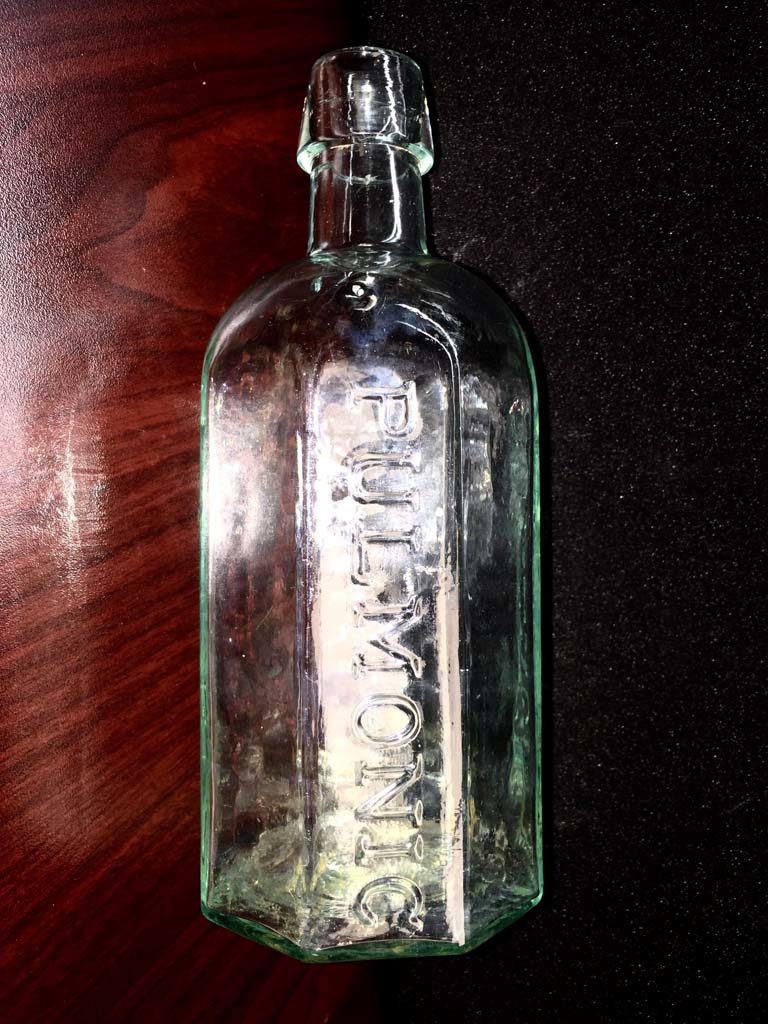

Schenk's Pulmonic Syrup
Schenk's Pulmonic Syrup was promoted as the "best and most positive cure for consumption, coughs, sore throat, hoarseness, whooping cough, and all other diseases of the throat, lungs, and respiratory organs." This bottle from the 1880s is from the collection of Felix Khusid.
Image from Felix Khusid


Cod Liver Oil for Consumption
Dr. L. J. DeJongh's light brown, Norwegian cod liver oil was marketed in the USA and England as a treatment for consumption and other wasting diseases. It was promoted from the mid 19th century well into the early 20th century. this ad appeared in 1885 in the London Times newspaper.

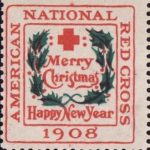
1908 Red Cross Christmas Seal
After learning about seals developed by a Danish postal worker in 1903 to raise money to fight tuberculosis, Emily Bissell designed and printed the first Christmas seals in the United States in 1907 to raise funds for the Brandywine Sanitorium in Wilmington, Delaware. She sold the stamps for a penny each. The following year the American Red Cross sponsored the fund-raising campaign. Their 1908 Christmas seal is shown.
The Red Cross remained a sponsor of the Christmas Seals through 1919. Sponsorship of the campaign was then transferred to the National Tuberculosis Association (which later evolved into the American Lung Association.)
The Red Cross remained a sponsor of the Christmas Seals through 1919. Sponsorship of the campaign was then transferred to the National Tuberculosis Association (which later evolved into the American Lung Association.)

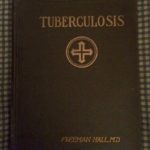
1912 Tuberculosis text
In 1912, Dr. Freeman Hall authored a text on tuberculosis which he described "the origin and treatment from the earliest times up to and including the present."
Dr. Hall was a former Acting Assistant Surgeon of the USA, a member of the International Tuberculosis Congress, and the National Association for the Study and Prevention of Tuberculosis.
Dr. Hall was a former Acting Assistant Surgeon of the USA, a member of the International Tuberculosis Congress, and the National Association for the Study and Prevention of Tuberculosis.
Image from Trudy Watson


TB Colonies on Boats
Ferries and riverboats were used in the early 1900s as "floating centers" to isolate and cluster individuals with "consumption" together where they could have plenty of fresh air. The vessel pictures, the Susquehanna was used as a TB camp circa 1910.
Image downloaded from the Library of Congress Prints and Photographs Division http://hdl.loc.gov/loc.pnp/pp.print


1912 Pulmonary Tuberculosis
Freeman Hall, MD included this image to represent a lung with chronic tuberculosis in his 1912 textbook "Tuberculosis". The book was published by the Yonkerman Company of Minnesota and distributed free to physicians to educate physicians and patients about the disease.
Image from Trudy Watson's copy of Freeman Hall's textbook


"Consumptives" on Board
In early 1900-1920 before sanitariums were readily available in some regions, riverboats and ferries were used to isolate those with active tuberculosis which were also known as "consumptives". In this image, a group of children are playing on deck of the "Susquehanna", a floating TB camp.
Image downloaded from the Library of Congress Prints and Photographs Division http://hdl.loc.gov/loc.pnp/pp.print
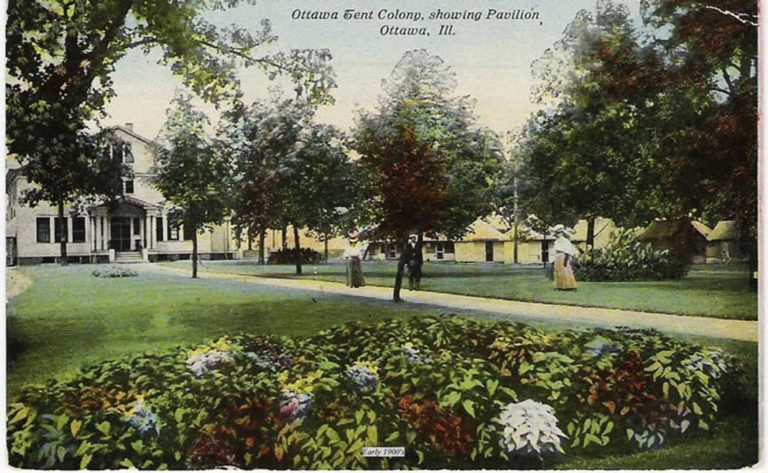

Tent Colony
An arly 1900s tent colony outside Ottawa, Illinois for individuals with tuberculosis is shown.


TB Camp in Winter
Imagine being ill and forced to remain outdoors in a tent or uninsulated structure all winter. In the Ottawa, Illinois area where this camp was erected, it would not have been uncommon to have snowfalls from late October into April and temperatures often reaching well below zero over the winter months. It must have been such a relief to those who survived the camps once the TB Sanitarium was built.
Image downloaded from the Library of Congress Prints and Photographs Division http://hdl.loc.gov/loc.pnp/pp.print


Red Cross Christmas Seal
The Red Cross participated in Christmas Seal campaigns against tuberculosis. An example from the early part of the 20th century is shown. (Not exactly a festive addition to one's holiday cards!)


TB & Influenza
This vintage poster from the Rensselaer County Tuberculosis Association of Troy, New York warned of the spread of pulmonary disease through careless coughing, spitting and sneezing.

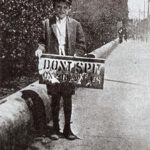
1916 "Don't Spit" Campaign
With the continued spread of tuberculosis in the 1900s, campaigns were initiated to educate the public to stop spitting on sidewalks and other public places. In 1916, the Anti-Tuberculosis League of Cincinnati, Ohio launched a campaign to stencil "Don's Spit on the Sidewalk" throughout the city.
After it was discovered that bacteria could survive in spittle on the streets and sidewalks, hem lengths on women's dresses (previously floor length) were shortened to avoid contamination.
After it was discovered that bacteria could survive in spittle on the streets and sidewalks, hem lengths on women's dresses (previously floor length) were shortened to avoid contamination.


Sputum Holder
After campaigns were launched to discourage spitting on streets, containers such as the one pictured were developed. Individuals with "consumption" were encouraged to expectorate into their personal sputum containers.


Anti-Spitting Campaign
An anti-spitting campaign to reduce transmission of tuberculosis was financed by the Christmas Seal Foundation was promoted by various public health departments across the country.


1920s Anti-TB Poster
Educational posters distributed by the National Child Welfare Association of New York and the National Association for the Study and Prevention of Tuberculosis encouraged good posture to prevent tuberculosis.
image downloaded Library of Congress Prints and Photographs Division Washington, D.C. 20540 USA http://hdl.loc.gov/loc.pnp/pp.prin


1920s Anti-TB Poster
Educational posters distributed by the National Child Welfare Association of New York and the National Association for the Study and Prevention of Tuberculosis encouraged fresh air, sunshine, good food and rest for children to prevent TB.
image downloaded Library of Congress Prints and Photographs Division Washington, D.C. 20540 USA http://hdl.loc.gov/loc.pnp/pp.prin


1921 War on Consumption
This image declaring "War on Consumption" was printed and distributed in 1921 by the Metropolitan Life Insurance Company.


1922 TB Camp
Patients with tuberculosis were often housed in private isolation huts in a camp setting where fresh air, rest, and good nutrition were considered essential for curing tuberculosis.
Image from a collection shared by Aracely Bigelow


1924 BCG Vaccine developed
In the nineteenth century and early twentieth century, TB was the number one killer. A vaccine developed by Dr. Albert Calmette and Dr. C. Guerin used an inactivated form of the TB bacillus to offer immunity against tuberculosis. (BCG is an acronym for Bacillus Calmette-Guerin.)


1925 Postural Drainage
Ambulatory TB patients were treated with special racks designed for postural drainage. This therapy was implemented several times a day with the patient coughing up infected sputum, ostensibly deposited in the sanitary basin supplied.
Image from a collection shared by Aracely Bigelow


1930s Prophylactic Heliotherapy
In 1913, August Bernhard published, Die Heliotherapie der Tuberculoses, in which he firmly established the necessity for the use of sunlight in treating the TB.
Heliotherapy is defined as "the systematic exposure of the nude body to the rays of the sun for treatment purposes." The advantage of the sun was said to be the blending of all ranges of radiation. A portion of the school day in the early part of the century, continuing into the 1930s, was taking school children outdoors and exposing them to the sun, as seen here. Heliotherapy remained an important part of treatment for tuberculosis well into the 1940s.
Heliotherapy is defined as "the systematic exposure of the nude body to the rays of the sun for treatment purposes." The advantage of the sun was said to be the blending of all ranges of radiation. A portion of the school day in the early part of the century, continuing into the 1930s, was taking school children outdoors and exposing them to the sun, as seen here. Heliotherapy remained an important part of treatment for tuberculosis well into the 1940s.
Image from a collection shared by Aracely Bigelow


Sun Bath for TB
This image to promote sun baths as a treatment for tuberculosis is from Newman Regional Medical Center in Kansas circa 1930.
Image from Karen Schell


Davidson Pneumothorax Apparatus
Dr. Louis Davidson invented the Davidson Pneumothorax Apparatus in 1933. The device was used to induce pneumothoraces in patients with active tuberculosis. Many physicians at that time believed that by collapsing the affected lung tissue, the lung would heal itself of the tuberculosis.
Image from Felix Khusid
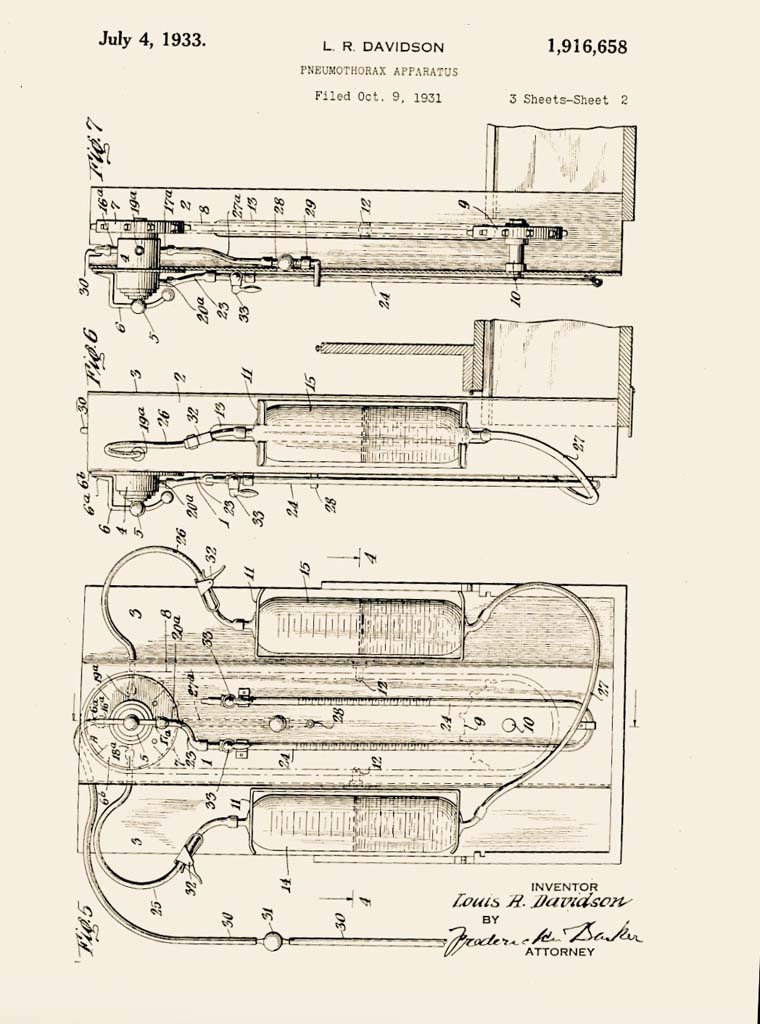

Davidson Pneumothorax Apparatus Patent
Louis Davidson filed a patent application for his Pneumothorax Apparatus on October 9, 1931. The patent was awarded on July 4, 1933.
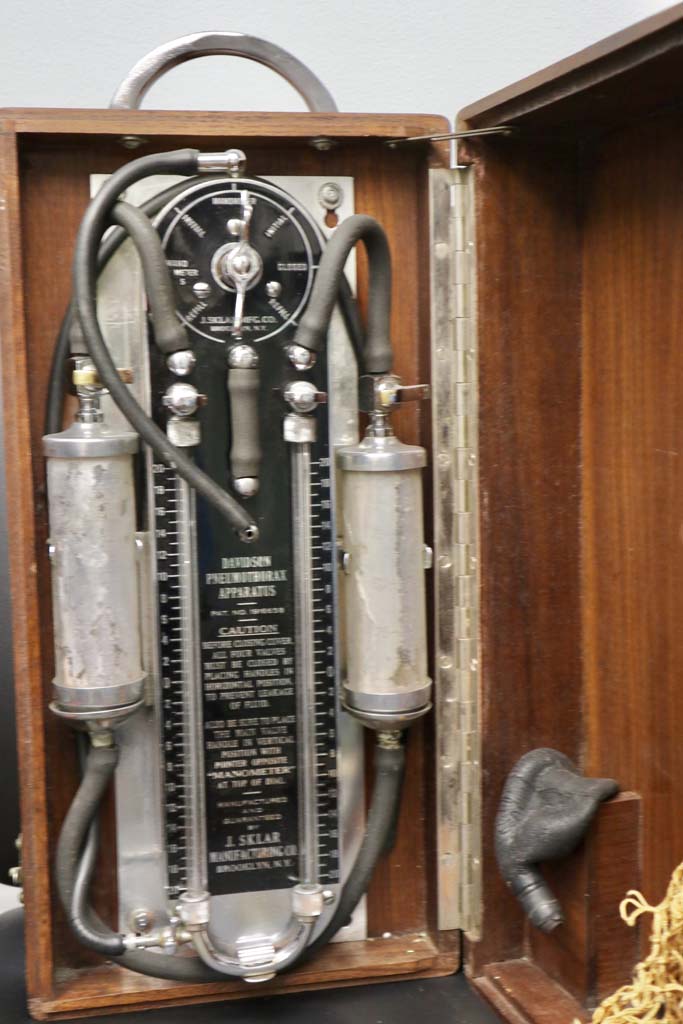

Davidson Pneumothorax Apparatus
This device was used in the 1930s and 1940s to induce a pneumothrax to collapse a lung patients with active pulmonary tuberculosis.
Image from Felix Khusid

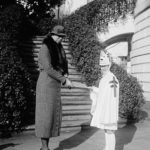
1933 Christmas Seals
First Lady Eleanor Roosevelt is shown receiving the first sheet of 1933 Christmas Seals from Florence Gwin.
Image downloaded from the Library of Congress Prints and Photographs Division http://hdl.loc.gov/loc.pnp/pp.print


Rock Island County (IL) TB San
The Rock Island County, Illinois TB Sanitarium (san) was built in 1931 with a capacity of 79 patients. This replaced a sanitarium built in 1917 which only had a 20 bed capacity.
The san closed in the mid 1970s. Lutheran Hospital, Moline IL was then the designated treatment site, with a 6 bed in- patient unit for individuals with active TB.
The san closed in the mid 1970s. Lutheran Hospital, Moline IL was then the designated treatment site, with a 6 bed in- patient unit for individuals with active TB.


Plombage
Plombage (or extrapleural pneumonolysis) was a treatment for cavitary tuberculosis of the upper lobes of the lungs. It was used in the 1930s-1950s. A cavity was created surgically under the upper ribs and filled with inert materials such as pingpong balls, lucite balls, paraffin wax, gauze, and rubber. The upper lobe of the lung would collapse. It was believed at that time that a collapsed lung would heal faster.
Image courtesy of Dr David Clemo Steel, "Radiopaedia.org/cases/plombage-lucite-spheres"


1936 TB Poster
This tuberculosis poster was from Hempstead, New York circa 1936.


1937 Fresh Air and Sunshine
Fresh air and sunshine were important components of treatment for the residents at TB Sanitariums.
This photo was taken in 1937 at a TB Sanitarium near Peoria, Illinois.
This photo was taken in 1937 at a TB Sanitarium near Peoria, Illinois.
Image from Trudy Watson


1937 Classes at the San
Since residents of TB sanitariums were often school age, tutors from area elementary schools and high schools assisted the residents with their studies.
This photo was taken of residents in a high school class of at a TB san near Peoria, Illinois in 1937.
This photo was taken of residents in a high school class of at a TB san near Peoria, Illinois in 1937.
Image from Trudy Watson


1938 TB Poster
This poster was issued in 1938 by the City of Chicago's Municipal Tuberculosis Sanitarium to encourage getting tested for tuberculosis.

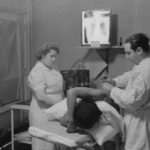
1941 Therapeutic Pneumothorax
In this 1941 photo, a patient with tuberculosis is undergoing a pneumothorax at a TB Sanitarium in the Chicago area.
Image downloaded from the Library of Congress http://hdl.loc.gov/loc.pnp/pp.print


1943 Streptomycin Discovered
Streptomycin, a powerful antibiotic, was discovered in the early 1940s, and was used to treat tuberculosis.


1948 Streptomycin Patented
In 1943, Selman Waksman and Albert Schatz discovered Streptomycin.
They filed a patent application for "Streptomycin and Process of Preparation" in February 1945 and were awarded the patent on September 21, 1948.
Waksman was awarded a Nobel prize in 1952.
They filed a patent application for "Streptomycin and Process of Preparation" in February 1945 and were awarded the patent on September 21, 1948.
Waksman was awarded a Nobel prize in 1952.


Thoracoplasty
A thoracoplasty was a surgical procedure in which a portion of ribs were removed to permanently collapse the underlying lung. Many patients with TB in the 1930s -1950s were subjected to this surgery.
Image from Steve and Mary DeGenaro


1949 Thoracoplasty Article
Thoracoplasty was promoted as a primary treatment for tuberculosis in this 1949 Canadian medical journal article.
Article appeared in Canad.M.A.J., Dec.1949, Vol.61


1950 "3 Ways to Fight TB"
This ad from Metropolitan Life Insurance Company featured three ways to fight TB: through an "X-ray examination at a doctor's office or chest clinic", prompt treatment "in a tuberculosis hospital which calls for complete bed rest to help the body heal the infection", and for those with active disease "to remain in the hospital until their disease is under control ."
The ad from 1950 also stated that the likelihood of developing TB is greatly reduced by getting plenty of sleep, rest, proper exercise, and nourishing food.
The ad from 1950 also stated that the likelihood of developing TB is greatly reduced by getting plenty of sleep, rest, proper exercise, and nourishing food.


Tuberculin Skin Test
For routine screening, a small amount of tuberculin is injected under the skin. The site is examined 48-72 hours later and the reaction site inspected and measured. A positive reaction means that the individual has been exposed to the bacteria that causes TB. Further testing is required to determine whether the individual has a latent infection or active disease.


Directly Observed Therapy
To ensure adherence with scheduled medications, directly observed therapy (DOT) is recommended for patients with active tuberculosis and was established as the standard of care for TB in the United States in the 1990s.


First Line of Defense
Isoniazid (INH) is used in combination with two or more of the following agents as the first line of defense against active tuberculosis: rifampin (RIF), pyrazinamide (PZA), and ethambutol (EMB).

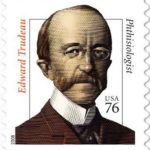
2008 Trudeau Stamp
In 2008, the United States Postal Service issued a 76 cent stamp honoring Dr. Edward Livingston Trudeau (1848-1915), the founder and first president of the National Association for the Study and Prevention of Tuberculosis. The stamp identifies Dr. Trudeau as a phthisiologt.


Worldwide TB Statistics
Statistics from the World Health Organization, March 2015.


Drug Resistant TB
Multi-drug resistant tuberculosis (MDR-TB) and extensively drug resistant tuberculosis (XDR-TB) have emerged.
MDR-TB results from an organism that is resistant to at least isoniazid and rifampin, the two most potent TB drugs.
XDR-TB is resistant to isoniazid and rifampin, any fluoroquinolone, and one or more of the second-line drugs (such as capreomycin, amikacin, or kanamycin).
Anti-TB drug resistance primarily occurs when patients do not complete their full course of treatment or when health-care providers prescribe the incorrect drug combinations, wrong duration, or incorrect dose.
MDR-TB results from an organism that is resistant to at least isoniazid and rifampin, the two most potent TB drugs.
XDR-TB is resistant to isoniazid and rifampin, any fluoroquinolone, and one or more of the second-line drugs (such as capreomycin, amikacin, or kanamycin).
Anti-TB drug resistance primarily occurs when patients do not complete their full course of treatment or when health-care providers prescribe the incorrect drug combinations, wrong duration, or incorrect dose.


Images to share?
If you have vintage images to share for this gallery (or others in the virtual museum,) click on the Contact link on the navigation bar of the virtual museum's home page and follow the instructions.